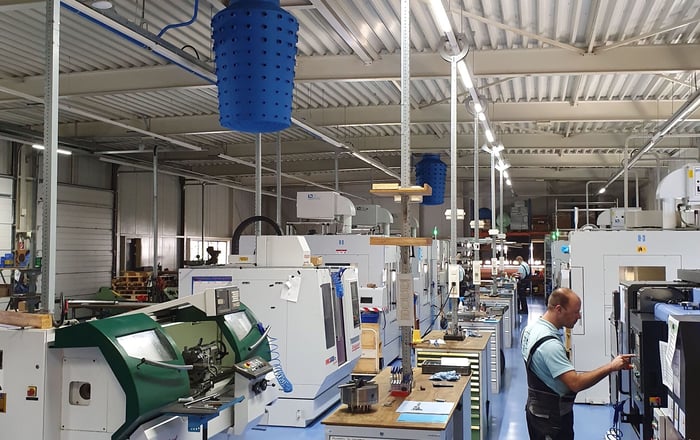The production facility is the powerhouse of an organization. It is vital to maintain a comfortable and healthy working environment for employees working on the production floor. Various studies show that comfortable indoor cooling not only increases the productivity of employees, but also reduces exhaustion, and absenteeism and improves the performance level of employees.
You are probably familiar with home air conditioners but when it comes to creating a comfortable and healthy working environment for a large space like a production facility, these should definitely not be the first choice. There are many constraints, like high electricity consumption, lack of fresh air, humidity, and overall cost, which make it difficult to choose the right indoor cooling option for a production facility. This blog illustrates various indoor cooling options to ensure a healthy and productive climate in your production facility - with stable indoor temperatures, air humidity, and optimal air quality.
Conventional air conditioning
Air conditioning systems cool down an area by removing the existing heat and moisture from that space. Air conditioners generally recirculate cooled indoor air to avoid extra energy use needed to cool and dehumidify incoming outdoor air. Air conditioning allows for comfortable cooling in all climates. However, the higher the outside temperatures, the more energy is needed to provide the required cooling capacity.
Heat pumps
The heat pump is an energy-efficient system that uses electricity to transfer the indoor heat to the outdoors to cool down the interiors of a building. With a heat pump, the COP (Coefficient of Performance) is around 3. Heat pumps are categorized into different types based on the heat source of the system. For large production facilities, water-source heat pumps are generally used to provide indoor cooling in scorching hot weather. With a centralized water circulation loop, heat pumps can be used as the primary source of heating and cooling for large buildings. However, it is very costly, energy-wise, to provide a fresh air ventilation system in the building while using water-source heat pumps for indoor cooling.
Cooling panels
Cooling panels, also called radiant panels, are installed on floors, walls, or ceilings that can be a source of cooling. These panel systems use tubes or pipes that are mostly placed below the ceiling to radiate the temperature. The installation of panel systems can be expensive in comparison to the other types of indoor cooling options, but it can be useful in case of a lack of space as they need just a few inches of space to be installed. Another advantage is that they are noiseless and do not create airflow. The disadvantage is that there is no ventilation with fresh air.
Evaporative cooling options
Evaporative cooling works by using water as a refrigerant instead of harmful chemicals and substances. Water is one of nature’s most powerful refrigerants. Water is an excellent alternative to the ozone-depleting R-22 refrigerant in conventional air conditioning.
Curious about how water-based cooling works? Read more about it in our blog: Water as a refrigerant.
Direct adiabatic cooling
In a direct adiabatic cooling system, the air is cooled down by increasing the air's humidity as the air is ventilated through wet evaporative media. This highly sustainable cooling solution needs only a little energy for the ventilator plus some water and saves up to 90% energy compared to traditional cooling techniques. In direct adiabatic cooling, the cooling performance is limited to the wet bulb. In practice, only 90% efficiency is reached, meaning the 1-3°C above the wet bulb, is not always efficient for achieving a comfortable climate in temperature and humidity.
Two-stage adiabatic cooling
The innovative and patented two-stage adiabatic cooling technology from Oxycom contains a dry cooling process in addition to an evaporative cooling process. In the first step, the air passes through an air-to-water heat-exchanger, cooling down the air to a lower wet bulb. Thereafter the air passes through wetted media, allowing for deeper cooling below the wet-bulb (4 to 7°C degrees lower than a direct process). Lower air temperatures can hold only a certain amount of humidity, meaning that the air contains considerably less humidity (60 to 70%) than in the direct process, thus allowing for more comfort while still saving 90% on energy consumption. An additional advantage of two-stage adiabatic cooling is its functionality in more humid climates.
For a clear comparison between this innovative cooling technique and conventional air conditioning, check out our page: two-stage evaporative cooling vs. air conditioning.
Energy-efficient indoor climate control for production facilities
The above shows there are many ways to improve the indoor climate for your production facility. There is often little to no climate control in production halls due to the sky-high (energy) costs associated with traditional cooling in combination with fresh air ventilation. Fortunately, there is a very effective and sustainable solution to this problem. Oxycom's patented industrial two-stage adiabatic cooling provides effective climate control at 90% of the cost of traditional cooling. Furthermore, two-stage adiabatic cooling provides not only cooling but also ventilation with fresh, filtered outside air. This dramatically improves the entire indoor climate and can increase productivity by up to 15%. This is a cost-saving option that is not taken into consideration by most production facility owners!
In our whitepaper “Challenges and opportunities for energy-efficient climate control,” we discuss this issue further and provide you with thé solution. Download the whitepaper for free:
Would you rather speak directly to an industrial indoor climate specialist to discuss your challenges? Please feel free to fill in the form below with your request. We are happy to help.





